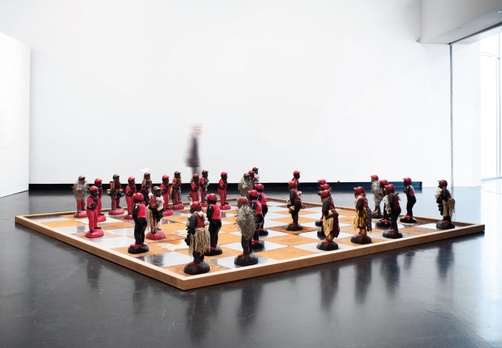Rebecca McNamara
Mellon Collections Curator
Tang Teaching Museum
What does it mean to get to the other side? Most simply, it is the answer to the question, “Why did the chicken cross the road?” A result of the artist’s fascination with double entendres, this characterization holds symbolic undertones.(1) The fowl, a commonly sacrificed animal in African religions, reflects an ability to traverse between different realms—land, water, sky (earth, spirit, space, time)—and in Yoruba practice specifically, “the fare fowl” is sacrificed to ease the deceased’s transition to afterlife.(2)
In To get to the other side, an oversize chessboard contains not fowl, but instead, thirty-two black-faced lawn jockey statues. Their faces are caricatured; their posture, hunched over and servile. The statues are part of a history of so-called black memorabilia in the United States: Mammy ashtrays, Aunt Jemima salt shakers, Uncle Tom cookie jars. The Jim Crow–era racism embedded within these figures cannot be erased, but Willie Cole’s lawn jockeys aren’t negative symbols: they’re about spirit, and about reclaiming power over an image.
Cole has reimagined the statues as stand-ins for the Yoruba gatekeeper god Elegba, imbuing each with the power of a deity who allows people—or not—to reach higher orishas, to get to the other side. Standing together en masse, the lawn jockeys transform into postures of strength, combat, and forward momentum. Named pieces hold knives in place of ring-in-hand hitching posts and are adorned with symbols and metaphors reflecting their roles on the gameboard. The rook, impoverished, carries his “castle”—his belongings held in bundles—on his back. His white-painted eyes suggest a spirit that lies within; physically made of cast concrete, each statue is figuratively a vessel. The knight’s concrete- and nail-ridden body is reminiscent of Congolese Nkisi statues. The bishop holds liquor bottles, containers, and pots—a literal positioning of his role as the carrier of spirits. The king and queen wear neckties, contemporary American “power cloths,” while strings of beads from Brazil reference deities in the diasporic Yoruba religion Candomblé. These are just a few of the seemingly endless meanings of individual adornment.
As a whole, the work expresses a singular goal—to get to the other side—but where that is and how one gets there are uncertain. The Tang’s configuration shows a rook about to be captured by a pawn. It is an anxious moment. Elegba is a gatekeeper but also a trickster; perhaps this is the moment when the god flips the switch, tricks a believer, tricks itself. There are two teams on the chessboard: will only one reach the other side? Cole has said of the work, “Chess is a game of war” and, “To get to the other side is a battle field.” To reach a higher spiritual realm, to get to the other—an other, any other—side, must we shed blood in sacrifice? Does the chicken ever make it across the road?



